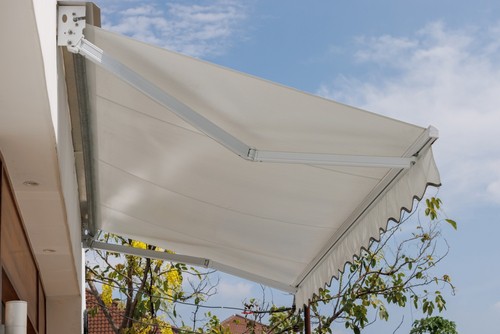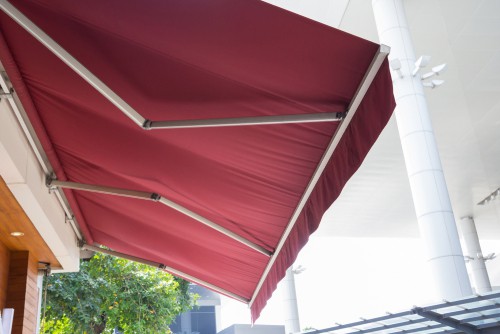
Retractable Awnings vs Fixed Awnings
July 25, 2023
Motorized vs Manual Awnings: Which Is Right for You in Singapore
October 16, 2023How Awnings Enhance Energy Efficiency in Singapore

How Awnings Enhance Energy Efficiency in Singapore
How Awnings Enhance Energy Efficiency in Singapore. Awnings may seem like a simple addition to buildings, but in Singapore’s sunny and humid climate, they are vital in enhancing energy efficiency.
This article will explore the significance of awnings and how they contribute to energy efficiency in a climate known for its relentless heat and high humidity.
We will begin by understanding Singapore’s unique climate, emphasizing the importance of energy efficiency, and presenting our thesis statement on the role of awnings in this context.
Understanding Singapore’s Climate
Singapore’s climate is characterized by its tropical nature, where specific seasons like winter or spring are virtually non-existent.
Instead, the city-state experiences consistent heat and high humidity throughout the year. This climate presents several challenges, particularly regarding energy usage and comfort.
In a city where temperatures typically range from 25°C to 31°C year-round, cooling becomes a necessity rather than a luxury.
The high heat and humidity levels increase energy consumption for air conditioning, creating a substantial demand on the power grid.
Additionally, the discomfort caused by heat and humidity can adversely affect the residents’ well-being.
The Role of Awnings in Energy Efficiency

Now that we understand Singapore’s climate let’s dive into how awnings contribute to energy efficiency in this unique context.
What Are Awnings?
Awnings are architectural elements that provide shade and shelter from the sun and rain.
They can be made from various materials and come in different types, including retractable, fixed, and motorized awnings. Their primary purpose is to shield buildings from direct sunlight and reduce heat gain.
Temperature Regulation
One of the key ways awnings enhance energy efficiency is by helping regulate indoor temperatures.
By blocking direct sunlight, awnings prevent excessive heat from entering buildings. This reduces the need for air conditioning and helps maintain a comfortable indoor environment.
Moreover, awnings also protect furnishings and interior décor from the harsh effects of UV rays, preserving the longevity of your furniture and reducing the need for replacements.
Cooling Benefits of Awnings
The cooling benefits of awnings extend beyond just comfort—they directly impact energy consumption and savings.
Significant Temperature Reduction
Awnings can reduce indoor temperatures by up to 15 degrees Celsius. This substantial reduction creates a more comfortable living and working environment, allowing residents and employees to stay productive without the discomfort of excessive heat.
Energy Savings
Reducing the reliance on air conditioning translates into significant energy savings.
Lower energy consumption not only leads to lower electricity bills but also contributes to reduced greenhouse gas emissions. Awnings, in this sense, are an eco-friendly solution to energy efficiency.
Aesthetics and Architectural Integration

Awnings are not just functional; they also add to the aesthetic appeal of buildings.
Enhancing Building Designs
Awnings come in various designs and materials, offering architects and designers flexibility in enhancing building aesthetics.
Whether it’s a sleek, modern look or a classic, timeless design, awnings can be customized to match the architectural style of any building.
Urban Architecture
In the urban landscape of Singapore, where architectural diversity is celebrated, awnings seamlessly complement various building styles. They provide an additional layer of visual interest while serving their functional purpose of energy efficiency.
Sustainability and Environmental Impact
In an era where sustainability is a global concern, awnings have a role to play in contributing to a greener environment.
Using awnings in energy-efficient buildings aligns with sustainability goals. Reduced energy consumption means lower greenhouse gas emissions, making awnings a sustainable choice for residential and commercial properties.
Maintenance and Longevity
Proper maintenance is essential to ensure the continued effectiveness of awnings in enhancing energy efficiency.
Maintenance Tips
Regular cleaning and inspection of awnings are essential to ensure they remain in optimal condition. This includes removing dirt, debris, and ensuring that the mechanisms (in the case of retractable or motorized awnings) are functioning correctly.
Cost-Effectiveness
Despite initial investments, awnings prove to be cost-effective in the long run. The energy savings achieved by reducing air conditioning usage and the extended lifespan of awnings make them a wise choice for property owners looking to manage energy consumption and costs.
Frequently Asked Questions

Q: Are awnings only suitable for residential buildings?
A: No, awnings are suitable for residential and commercial buildings, offering energy-saving benefits to various property types.
Q: Do awnings require a lot of maintenance?
A: Awnings require regular cleaning and inspection, but proper maintenance is relatively straightforward and ensures their longevity.
Q: Can awnings be customized to match the architecture of a building?
A: Yes, awnings come in various designs and materials, allowing for customization to complement the architectural style of any building.
Q: Do awnings help reduce electricity bills?
A: Yes, by reducing indoor temperatures and the need for air conditioning, awnings can substantially save electricity bills.
Q: Are there any government incentives for using awnings in Singapore?
A: Yes, the Singaporean government supports using awnings through incentives and regulations to promote energy efficiency.
Q: How do awnings contribute to sustainability?
A: Awnings reduce energy consumption and lower greenhouse gas emissions, aligning with sustainability goals.
How Awnings Enhance Energy Efficiency in Singapore – Conclusion

In conclusion, awnings are more than just decorative elements on buildings in Singapore; they are integral to enhancing energy efficiency.
By regulating indoor temperatures, reducing energy consumption, and contributing to sustainability, awnings play a pivotal role in the future of energy-efficient architecture.
As Singapore prioritizes energy efficiency, consider embracing the shade and contributing to a greener future by adding awnings to your property.
Looking for professional and reliable awning installation services in Singapore? Contact us today!



